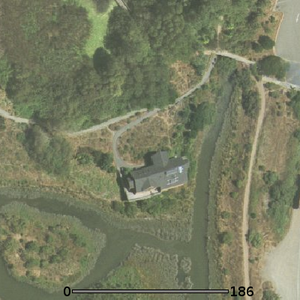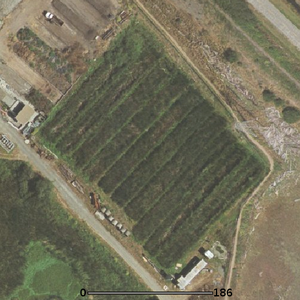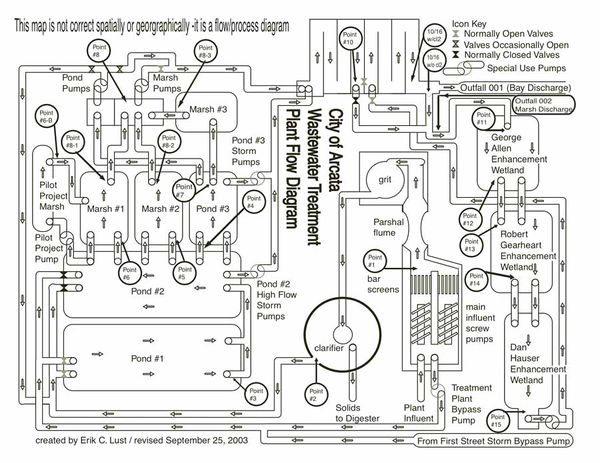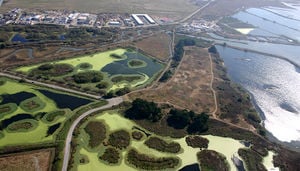
The Arcata Wastewater Treatment Plant is responsible for the treatment of the sewage for the city of Arcata. The Arcata Marsh and Wildlife Sanctuary is a part of the system that cleans our waste in preparation to be released back into the water cycle. The system as a whole is the wastewater treatment plant (WWTP). The Arcata Wastewater Treatment Plant personnel maintain 11 wastewater pump stations as well as all of the equipment, motors, and pumps associated with the plant. They also are responsible for the operation and maintenance, of the 55 acres of oxidation ponds and 154 acres of treatment and enhancement marshes. The Arcata Marsh and Wildlife Sanctuary is a constructed wetland and is part of the Arcata Wastewater Treatment Plant. This use of constructed wetlands is what separates the Arcata Wastewater Treatment Plant from other Wastewater Treatment Plants. The first treatment plant was built in 1946 and discharged unchlorinated primary treated wastewater into the bay.
Location[edit | edit source]
The Arcata Marsh and Wildlife Sanctuary, which is an integral part of the Arcata Wastewater Treatment Plant is located in Arcata, CaliforniaW. Arcata is a town of roughly 17,300[1]people and is located on the northern part of Humboldt Bay. Arcata is the home of Cal Poly Humboldt and is in the heart of the Redwoods of Humboldt County.
Purpose[edit | edit source]
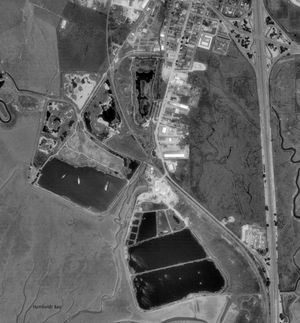
The Arcata Wastewater Treatment Plant is responsible for the treatment of the sewage for the city of Arcata. The Arcata Marsh and Wildlife Sanctuary is a part of the system that cleans our waste in preparation to be released back into the water cycle. The system as a whole is the wastewater treatment plant (WWTPW). The Arcata Wastewater Treatment Plant personnel maintain 11 wastewater pump stations as well as all of the equipment, motors, and pumps associated with the plant. They also are responsible for the operation and maintenance, of the 55 acres of oxidation ponds and 154 acres of treatment and enhancement marshes.[2]
The Arcata Marsh and Wildlife Sanctuary is a constructed wetland and is part of the Arcata Wastewater Treatment Plant. This use of constructed wetlands is what separates the Arcata Wastewater Treatment Plant from other Wastewater Treatment Plants. The first treatment plant was built in 1946 and discharged unchlorinated primary treated wastewater into the bay.[3]Since then, the Arcata Wastewater Treatment Plant has undergone expansions and improvements due to governmental mandates and population growth.
Components[edit | edit source]
The functions of the Arcata Wastewater Treatment Plant can be split into three major categories:
- Primary Treatment
- Primary treatment consists of the pre-filtering methods in the headworks. Large and settable debris are removed from the wastewater.
- Bar screens, grit removal, and sedimentation are physical processes used to remove solids.
- Secondary Treatment
- Secondary wastewater treatment uses biological processes to break down the organic matter in the wastewater.
- Oxidation ponds and treatment wetlands are utilized to encourage bacterial activity.
- Tertiary Treatment
- In Tertiary wastewater treatment, the wastewater is filtered for particulate matter, nutrients are removed, and the wastewater is disinfected.
- The Arcata Wastewater Treatment Plant utilizes enhancement marshes and chlorination.
Primary Treatment[edit | edit source]
Headworks[edit | edit source]
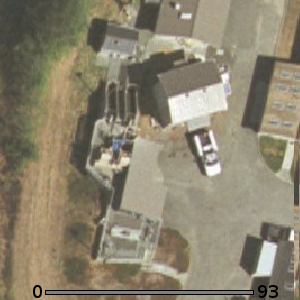
Raw sewage from the city enters the plant at this point. Two Archimedes' screwW pumps lift the sewage fifteen feet from the influent lines to the headworks where processing begins. From the screw pumps the raw wastewater is passed through bar screens which eliminate large debris to keep the system running smoothly. After the bar screens the wastewater is passed through a Parshall flume for the purpose of measuring inflow. Finally the wastewater is run through grit separators before entering the clarifiers. The grit separators remove particles such as sand, pebbles, and small pieces of glass.
Clarifier[edit | edit source]
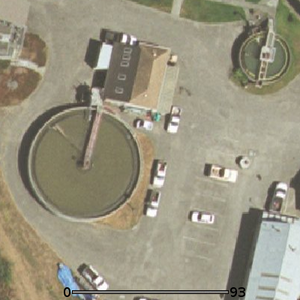
The clarifier is the component that is responsible for settling out any suspended material that remains after the headworks. Heavier solids settle to the bottom of the tank and are removed. These settled solids are pumped to the digesters. Solids that cannot be settled are removed by the skimmer and deposited into a dumpster. The skimmer typically removes floating solids and oils. The wastewater that passes through the clarifier is pumped into the oxidation ponds.
Digesters[edit | edit source]
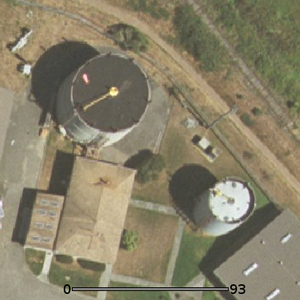
The digesters (Figure 4.) utilize anaerobic bacteriaW to break down the solid waste from the clarifiers. Anaerobic digestion not only breaks down the sewage sludge most effectively, it also reduces the issue of odor. The anaerobic bacteria also produce methane which is used to heat the primary digestor.[4]Two digesters are utilized at the Arcata Wastewater Treatment Plant before the sludge is pumped into the drying beds. Figure 4 shows the primary heated digester on the upper left, and the smaller secondary unheated digester on the bottom right.
Drying Beds[edit | edit source]
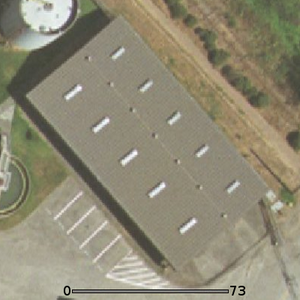
Sludge processed in the digesters is pumped into one of two covered drying beds (Figure 5.) where it sits for up to six months. The drying beds are rectangular and about four feet deep at the center. One roof covers both drying beds. The floors are sloped down toward the center of each bed to allow water to collect. There is one drain at the center of the bed to assist in dewatering. The purpose of drying the sludge is to make it easier to transport as well as allowing for better composting. The sludge often looks solid due to its stagnant state, however its ratio of solid to liquid varies over the year.
Compost[edit | edit source]
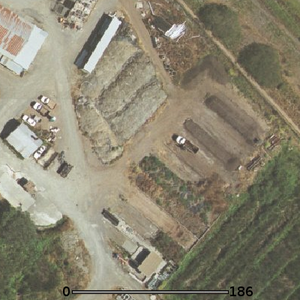
When the sludge is completely dried, it is removed from the drying beds and transported to the compost area. The dried sludge is mixed with other organic matter and is left in long piles to continue its decomposition. A vertical auger mixer is used to aerate and mix the compost. Temperatures inside the pile can reach 60 Celsius (140 Fahrenheit).[5]After the composting process is complete, the composted waste is considered a Class A- Exceptional Quality biosolid[6] and is used in city parks as fertilizer.
Secondary Treatment[edit | edit source]
Oxidation Ponds[edit | edit source]
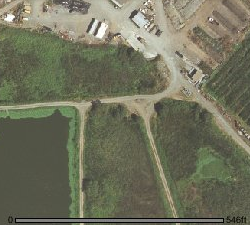
After the clarifiers separate the sludge from the wastewater, the wastewater is pumped to the first in a series of oxidation ponds. These ponds are responsible for further settlement of solids as well as the reduction of Biological Oxygen Demand (BODW). The ponds cover about 55 acres and are about five feet deep. Having this large surface area allows for algal growth that introduces oxygen into the water. This oxygen boost allows aerobic bacteriaW at the surface to break down the organic matter in the wastewater. Toward the bottom of the ponds where there is less oxygen, anaerobic bacteria break down the settled material in a similar fashion to the digesters. The flora in the oxidation ponds helps to extract nitrogen and phosphorus.
Treatment Wetlands[edit | edit source]

The treatment wetlands of the Arcata Wastewater Treatment Plant are responsible for filtering out suspended solids, nutrients, organic matter, and metals. This is done using wetlands that cover approximately 7.5 acres and average 2 feet in depth.[7]These wetlands are completely covered in aquatic plants that both slow the flow of the water as well as assist in the absorption of the nutrients, metals, and organic compounds in the water.
Tertiary Treatment[edit | edit source]
enhancement ponds[edit | edit source]
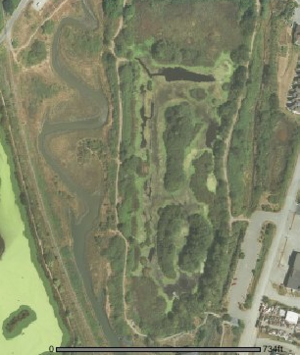
The enhancement marshes of the Arcata Wastewater Treatment Plant are responsible for removing some of the pollutants that remain from the other secondary treatment systems. Biological processes remove some levels of nitrogen, phosphorous, and heavy metals. By using enhancement marshes, the Arcata Wastewater Treatment Plant is able to forgo the use of machines and chemicals that would normally have to be used to achieve the same result.
Pipes[edit | edit source]
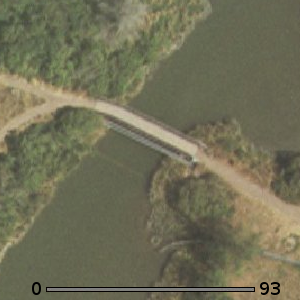
Two pipes carry water to and from the enhancement marshes. The pipe attached to the bottom side of the footbridge (Figure 12.) carries water to the enhancement marshes. The lower one, seen south of the bridge, carries water from the enhancement marshes to the chlorination facility. In Figure 12, the return pipe can be seen as a lighter line to the bottom left of the bridge. During a low tide the pipes can be seen under the bridge.
Disinfection[edit | edit source]
Disinfection[edit | edit source]
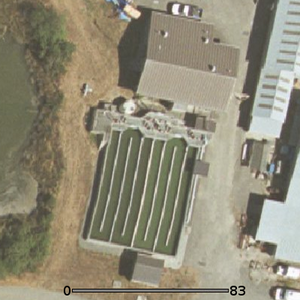
The disinfection process is responsible for killing off any bacteria from the treated sewage before it is discharged into Humboldt Bay.The Arcata Wastewater Treatment Plant uses chlorine to disinfect the treated water. Precautions must be made to ensure that the chlorine infused to the water does not create any by-product chemicals that would cause harm in the ecosystem after being discharged. Any chlorine remaining in the effluent wastewater after 60 minutes is removed using sulfur dioxide.[8]Any wastewater that is run through the treatment marshes must be disinfected before it can be discharged.
Another common process is UV disinfection which kills bacteria using ultraviolet light. The Arcata Wastewater Treatment Plant is in the process of conducting a study to determine if UV filtration is appropriate for their system.
Discharge[edit | edit source]
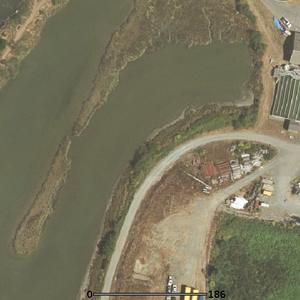
After Chlorination, treated wastewater is discharged into Humboldt BayW. Discharged water must have concentrations lower than 30 mg/L for Biological Oxygen Demand (BODW) and 30 mg/L for Total Suspended Solids (TSSW) to comply with National Pollutant Discharge Elimination System (NPDES) standards. It is important for these regulations to be met for this location as this water flows through the bay. On the journey through the bay this water will pass oyster farms and the Humboldt Bay Marina.
During a low tide the pipe that discharges the treated water can be seen emptying into the slough.
Diagram of flow[edit | edit source]
This diagram illustrates the flow that wastewater makes through the Arcata marsh system.
Map[edit | edit source]
See also[edit | edit source]
- Category:Arcata Marsh
- Arcata marsh History of the Land
- Arcata marsh influent
- Arcata marsh headworks
- Clarifier
- Arcata marsh digester
- Arcata marsh compost
- Arcata Treatment Wetlands
- Wastewater Secondary treatment
- Arcata Marsh Saltwater Marshes
- Arcata Marsh tertiary treatment
- Chlorination
- Wastewater treatment effluent
External links[edit | edit source]
- Cal Poly Humboldt - Arcata Marsh and Wildlife Sanctuary
- City of Arcata - Arcata Marsh & Wildlife Sanctuary
- Tour of a Washington state sewage plant written by an employee
- TIME Magazine - Arcata Marsh and Wildlife Sanctuary
References[edit | edit source]
- ↑ http://www.dof.ca.gov/HTML/FS_DATA/STAT-ABS/documents/B4.xls
- ↑ http://www.arcatacityhall.org/index.php?option=com_content&task=view&id=26&Itemid=53#wastewater
- ↑ Arcata Marsh Wildlife Sanctuary - Map and Guide, April 1994
- ↑ http://web.archive.org/web/20090522110942/http://www.monsal.com:80/pages.asp?ContentID=1
- ↑ http://web.archive.org/web/20091018183435/http://www.transformcompost.com:80/Enviro-Processor.htm
- ↑ http://web.archive.org/web/20100722112204/http://www.epa.gov/owm/mtb/biosolids/genqa.htm
- ↑ http://web.archive.org/web/20090627110322/http://www.humboldt.edu:80/~ere_dept/marsh/flow3b.html
- ↑ A Natural System for Wastewater Reclamation and Resource Enhancement, Arcata, CA
Toolbox[edit | edit source]
